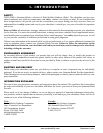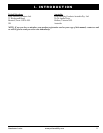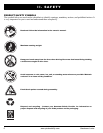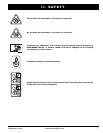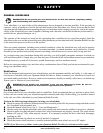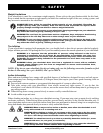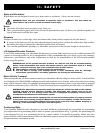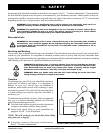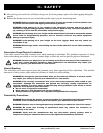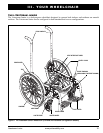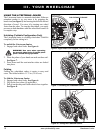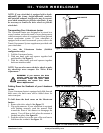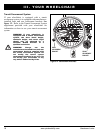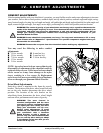
12 www.pridemobility.com Litestream Junior
II. SAFETY
Stairs and Escalators
Wheelchairs are not designed to travel up or down stairs or escalators. Always use an elevator.
WARNING! Never use your wheelchair to negotiate steps or escalators. This may cause the
wheelchair to tip or result in a fall and cause severe injury.
Doors
Determine if the door opens toward or away from you.
Drive your wheelchair gently and slowly forward to push the door open. Or drive your wheelchair gently and
slowly backward to pull the door open.
Elevators
Modern elevators have a door edge safety mechanism that, when pushed, reopens the elevator door(s).
If you are in the doorway of an elevator when the door(s) begin to close, push on the rubber door edge or allow
the rubber door edge to contact the wheelchair and the door will reopen.
Use care that pocketbooks, packages, or wheelchair accessories do not become caught in elevator doors.
Lift Systems/Elevation Products
If you will be transporting your wheelchair during travel, you may find it necessary to use a vehicle-mounted lift
system or elevation product to aid in transportation. Pride recommends that you closely review the warnings,
instructions, specifications, and safety information set forth by the manufacturer of the lift/elevation product
before using that product.
WARNING! Not all lift systems/elevation products are rated for use with an occupied mobility
device. Pride recommends that you do not remain seated in your wheelchair when it is being
used in connection with any type of lift system/elevation product unless:
That product is rated for occupied use by the manufacturer.
You are able to occupy your mobility device in strict conformity with the warnings,
instructions, specifications, and safety guidelines set forth by the manufacturer.
Motor Vehicle Transport
Pride recommends that you do not remain seated in your wheelchair while traveling in a motor vehicle. Your wheelchair
was designed to be folded (foldable configuration only) and stored in a secure location, such as the trunk of a car, during
motor vehicle transport, unless it is equipped with an optional transit securement system. If your wheelchair is equipped
with a transit securement system, refer to the Transit Securement System supplement provided with your wheelchair.
WARNING! The wheelchair user should transfer into the motor vehicle seat and use the vehicle-
installed restraint system whenever feasible. The wheelchair user should never sit in the
wheelchair while it is in a moving vehicle unless it is equipped and properly secured with a
manufacturer-installed transit securement system.
WARNING! Ensure wheelchairs equipped with a transit securement system are properly secured
to the motor vehicle during transport. Wheelchairs that are not properly secured can become a
hazard to the user and to other vehicle passengers in the event of a crash, sudden stopping, or
swerving, as the wheelchair could tip or slide out of place.
Positioning Belts
Your Quantum Rehab Provider, therapist(s), and other healthcare professionals are responsible for determining
your requirement for a positioning belt in order to operate your wheelchair safely. Typically, the positioning belt
is not designed for use as a restraining device in a motor vehicle. You should be properly belted into seats
approved by the vehicle manufacturer with your wheelchair properly stowed for vehicle transport or secured using
an optional transit securement system.



